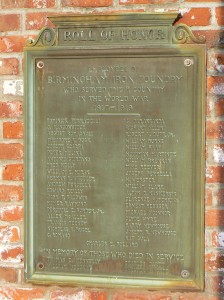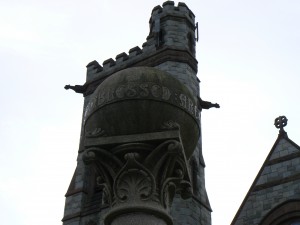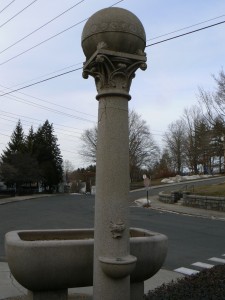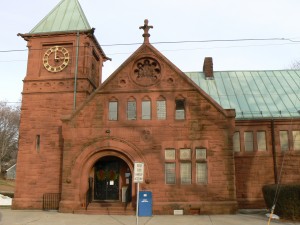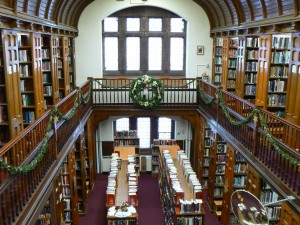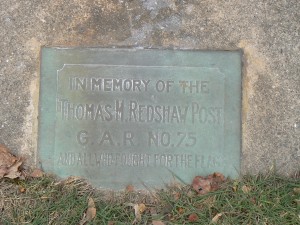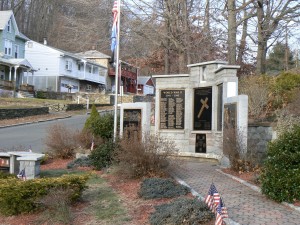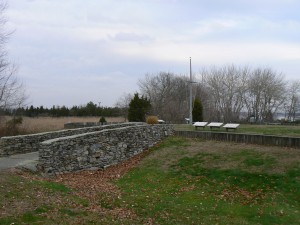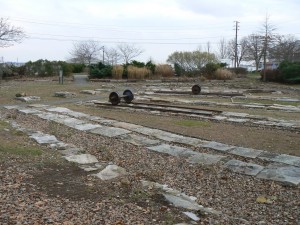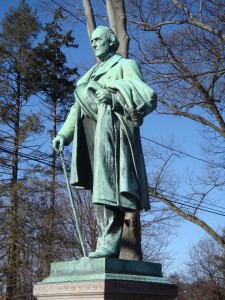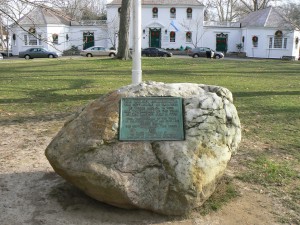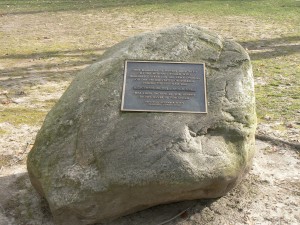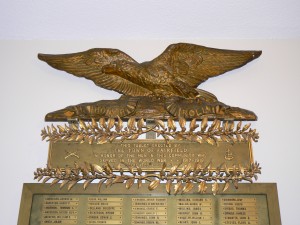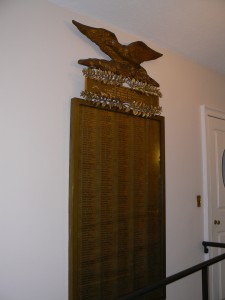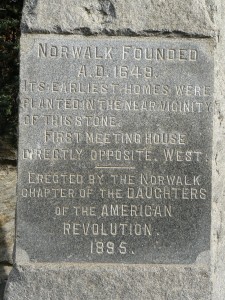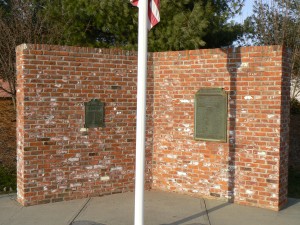 Memorial plaques honoring Farrel Corp. employees who served in the World Wars were spared when the company’s Derby factories were demolished in 2000.
Memorial plaques honoring Farrel Corp. employees who served in the World Wars were spared when the company’s Derby factories were demolished in 2000.
The plaques now stand as part of a Main Street monument (near the corner of Water Street) built when the former Farrel site was replaced by a Home Depot.
The western plaque lists the names of 25 employees who were lost in World War II. The plaque bears the dedication “In memory of Farrel-Birmingham employees who gave their lives for their country in World War II.”
The eastern honor roll plaque honors “Employees of Birmingham Iron Foundry who served their country in the World War 1917-1919,” and lists the names of 39 employees who served. The bottom section highlights four additional employees who were killed in the conflict.
 When the former Farrel manufacturing facilities were developed into the Home Depot site in 2000, the plaques were mounted on a brick monument that also features a flagpole.
When the former Farrel manufacturing facilities were developed into the Home Depot site in 2000, the plaques were mounted on a brick monument that also features a flagpole.
Farrel Corp., in nearby Ansonia, traces its roots to the 1830s, when two brothers moved a business that cast clock weights from the Westville section of West Haven to Birmingham, a boro on the westerns side of the Naugatuck River that now comprises Derby’s downtown area.
The Birmingham Iron Foundry was founded in 1850, and, across the river, the Farrel Foundry began making components for processing equipment used in the production of rubber tires, cereal and paper.
During the Civil War, both foundries produced cannon barrels and bayonet rolling machines.
In 1927, the companies merged to form the Farrel-Birmingham Company, which adopted the Farrel Corp. name in 1963. In the years since, the company has changed ownership several times, most recently being acquired by the HF Machinery Group division of the German company L. Possehl & Co. in 2009.
Tags: Derby
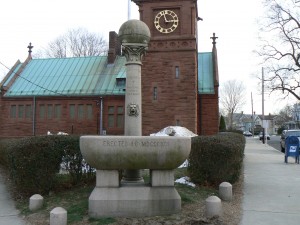 The author of the children’s classic “Black Beauty” is honored with a memorial fountain outside the Ansonia Public Library.
The author of the children’s classic “Black Beauty” is honored with a memorial fountain outside the Ansonia Public Library.
The library and the fountain, at the corner of Cottage Avenue and South Cliff Street, were both donated by Caroline Phelps Stokes to honor her parents as well as her grandfather, Ansonia founder Anson Phelps.
The fountain, dedicated in 1892, features a large trough for horses as well as a smaller fountain below a conch-shell spigot for people. A column behind the trough has a dedication reading, “In memoriam, Anna Sewell, author of ‘Black Beauty.’” The trough is dated 1891 in Roman numerals, although the fountain and library were dedicated on June 9, 1892.
The globe topping the column bears the inscription, “Blessed are the merciful.”
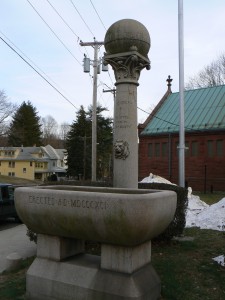 The flagpole behind the fountain honors the local Grand Army of the Republic post. The G.A.R. was the leading fraternal organization for Union Army veterans following the Civil War, and local posts were responsible for the funding of several Civil War monuments and memorial halls within Connecticut.
The flagpole behind the fountain honors the local Grand Army of the Republic post. The G.A.R. was the leading fraternal organization for Union Army veterans following the Civil War, and local posts were responsible for the funding of several Civil War monuments and memorial halls within Connecticut.
Stokes, a dedicated philanthropist who funded the construction of several college chapels and made donations to a variety of causes benefitting women, African-Americans, education and animals, funded the fountain to honor Anna Sewell, who had died shortly after the book’s publication in 1878.
Contemporary published accounts place the value of Stokes’ library donation at between $35,000 and $40,000, which would be nearly $1 million in today’s dollars.
Although the library was dedicated in 1892, it did not open until 1896. The building sat vacant for four years following a funding dispute with the municipal government about the library’s operating expenses (which local officials agreed to assume in 1896). The library building was expanded in 1960.
UPDATE (Jan. 13, 2010) – The Valley Independent Sentinel is reporting that the Friends of the Ansonia Historical Commission is raising funds to restore the fountain and repair vandalism damage from the 1960s, when miscreants broke the column by attaching a chain to the car. The group plans to first repair the visible cracks, and a later project will repair the trough’s water pump.
Tags: Ansonia
 An Ansonia neighborhood honors residents who have served in recent wars with a granite monument on a small hillside.
An Ansonia neighborhood honors residents who have served in recent wars with a granite monument on a small hillside.
The Woodbridge Avenue Honor Roll, near the intersection with Visselli Court (named after the first resident lost in World War II), is the latest version of a monument that started informally during the Second World War and has been revised several times since.
Today, the monument features a central monument, with three bronze plaques, dedicated to World War II veterans. The central plaque lists the names of nine neighborhood residents who were killed in the war, and features a large cross and a prayer to the Blessed Mother (who is represented with a small figurine inset into the monument). A dedication plaque on the lower section honors veterans of all of the nation’s wars, and features the crests of the military services.
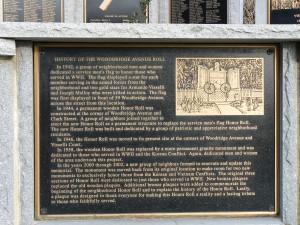 The central plaque is flanked by two markers that collectively list nearly 250 names of local WWII veterans.
The central plaque is flanked by two markers that collectively list nearly 250 names of local WWII veterans.
The monument also features plaques honor the service of veterans in the Korean and Vietnam wars. The Korean War plaque lists 50 names. The Vietnam plaque lists 56 residents who served in the conflict and highlights two who were killed.
It is striking to see the similarities of the names on the plaques. It is common to see four or five members of a family who served in the same conflict, and it is also common to see the same last name represented on the different plaques – undoubtedly relatives of veterans of the previous war.
Three smaller monuments lower on the hillside describe the history of the monument, which started in 1942 with a flag honoring local veterans and war heroes. A wooden honor roll was built two years later, and was replaced with a granite monument in 1958.
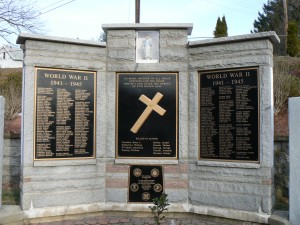 In 2002, the monument was updated and renovated, and moved to its current location. The wooden plaques were replaced with today’s bronze markers.
In 2002, the monument was updated and renovated, and moved to its current location. The wooden plaques were replaced with today’s bronze markers.
Tags: Ansonia
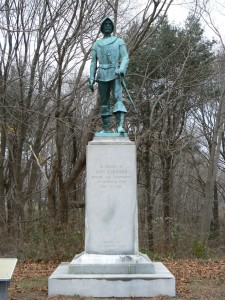 Old Saybrook maintains the site of New England’s first fortification as a park featuring elevated boardwalks through a scenic riverside marsh.
Old Saybrook maintains the site of New England’s first fortification as a park featuring elevated boardwalks through a scenic riverside marsh.
Fort Saybrook Monument Park, near where the Connecticut River empties into Long Island Sound, marks the site of a 1636 fort constructed by English military engineer Lion Gardiner to defend the Old Saybrook settlement during fighting between English settlers and the Pequot tribe.
Gardiner is honored with a 1930 statue created by sculptor William Ordway Partridge, who was also responsible for at least 60 other public statues and busts. A dedication on the front (south) face of the monument’s pedestal reads, “In memory of Lion Gardiner, builder and commander of Saybrook Fort, 1635-1639.”
In 1639, Gardiner, who became friendly with local Native Americans, settled an island off the east end of Long Island that would later bear his family’s name. Descendents continue to own the island 11 generations later.
Along with the Gardiner statue and a small fence marking the site of the original fort, the 18-acre park also features the former site of the Connecticut Valley Railroad’s roundhouse and end-of-the-line turntable. Train tracks and wheels show where trains were once turned around for northbound trips.
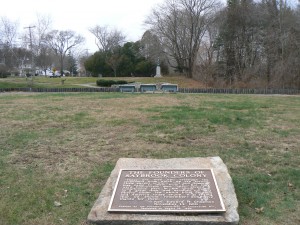 The site was transferred from the state to Old Saybrook in 1981 and developed into a park.
The site was transferred from the state to Old Saybrook in 1981 and developed into a park.
A number of wayside markers provide information about the fort, the settlement of Old Saybrook, the railroad, and the nearby river and marshlands. An extensive network of boardwalks across the marsh area provides the opportunity to see coastal birds and wildlife.
Tags: Old Saybrook
 Bridgeport honors the donor of the city’s Beardsley Park with a statue near the park entrance.
Bridgeport honors the donor of the city’s Beardsley Park with a statue near the park entrance.
In 1875, Beardsley, a farmer and cattle dealer, donated more than 150 acres of land in the city’s north end for use as a park. Frederick Law Olmstead, the landscape architect responsible for New York’s Central Park and Bridgeport’s Seaside Park, designed Beardsley Park.
The 1909 statue of Beardsley, at the park’s Noble Avenue entrance, depicts a standing figure with a cane in his right hand, and a hat in his left. An overcoat is draped over his left forearm.
A dedication on the south face of the monument’s base reads “In memory of James W. Beardsley, donor of Beardsley Park. Erected by the people of Bridgeport MDCCCCIX (1909).”
The statue was sculpted by Charles Henry Niehaus, who was also responsible for a number of public statues and monuments, including several outdoor statues at the state capitol building in Hartford.
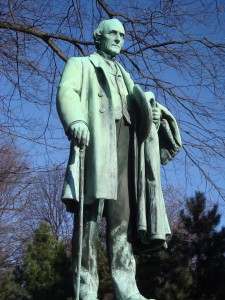 The centerpiece of Beardsley Park is Connecticut’s Beardsley Zoo, which was established by the city of Bridgeport in the early 1920s and became independent in 1997. The park is also a popular outdoor recreation and picnicking facility.
The centerpiece of Beardsley Park is Connecticut’s Beardsley Zoo, which was established by the city of Bridgeport in the early 1920s and became independent in 1997. The park is also a popular outdoor recreation and picnicking facility.
Beardsley, who used the land for farming before he donated it to the city, was killed in his home during an 1892 burglary. His murder was never solved.
Sources:
Smithsonian American Art Museum, Art Inventories Catalog
Samuel Orcutt, A History of the Old Town of Stratford and the City of Bridgeport, Connecticut
George Curtis Waldo, History of Bridgeport and Vicinity, Volume 1
Tags: Bridgeport
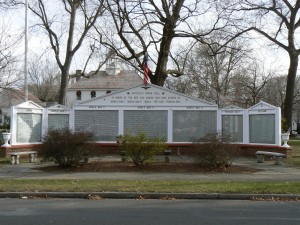 Fairfield honors local veterans with a large honor roll display on the town’s historic green.
Fairfield honors local veterans with a large honor roll display on the town’s historic green.
The honor roll features seven large panels with the names of local residents who served in the nation’s 20th century wars as well as on the ongoing conflicts in Iraq and Afghanistan.
Starting at the far left, the Korea war section has 10 columns of names engraved on small aluminum plaques. The World War I section displays seven columns of names.
The three central panels honoring World War II veterans each feature 16 columns of names, while the “Persian Gulf” panel honors residents who served in the 1990 Gulf War, the current fighting in Iraq in Afghanistan, and other conflicts including Lebanon, Grenada, the Dominican Republic, and Panama.
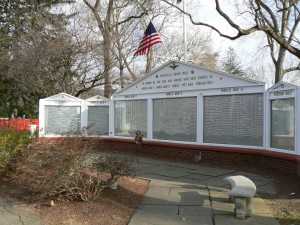 The far right panel included 10 columns of names honoring local Vietnam veterans.
The far right panel included 10 columns of names honoring local Vietnam veterans.
The site is also decorated with flagpoles, shrubbery and two benches.
Directly behind the honor roll monument, a boulder commemorates the 1639 founding of Fairfield and the 1779 burning of the town by British forces during the American Revolution. The boulder was dedicated in 1900 by a local DAR chapter.
Also near the honor roll is a boulder, dedicated in 1979, that honors local Vietnam War veterans.
The honor roll stands in front of Fairfield’s Old Town Hall, sections of which date back to 1794. A 1936 plaque inside the building describes its history and its expansion in 1870.
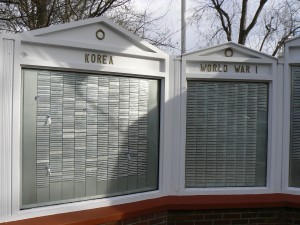 World War I veterans are also listed on a 1919 Honor Roll just off the Town Hall lobby. Its location in a narrow hallway made photography challenging.
World War I veterans are also listed on a 1919 Honor Roll just off the Town Hall lobby. Its location in a narrow hallway made photography challenging.
A plaque outside Town Hall commemorates a 1984 campaign appearance by President Ronald Reagan.
Tags: Fairfield
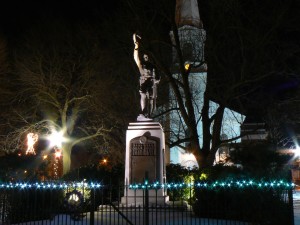 The fence surrounding the Armistice Monument on West Haven’s green was decorated with festive lights as we drove past on Christmas Eve, so we pulled over to take a couple of pictures.
The fence surrounding the Armistice Monument on West Haven’s green was decorated with festive lights as we drove past on Christmas Eve, so we pulled over to take a couple of pictures.
The monument was first dedicated in 1928 to honor World War veterans, and additional plaques were added to the base to honor veterans of World War II, Korea and Vietnam. A separate marker at the monument’s base honors a local hero of the current war in Iraq.
Here’s a look at the monument from our visit in March.
Tags: West Haven
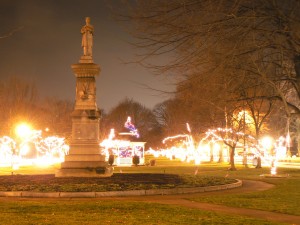 We’re paying a return visit to the 1888 Soldiers’ and Sailors’ monument on Milford’s green, and this time we’re including the holiday lights decorating the green.
We’re paying a return visit to the 1888 Soldiers’ and Sailors’ monument on Milford’s green, and this time we’re including the holiday lights decorating the green.
We first looked at the monument last February, when the green was covered with snow. And we paid a return visit to the monument in early May, when the planting bed at the base of the monument was filled with a variety of festive spring flowers.
We hope you’re enjoying this year’s holiday season.
Tags: Milford
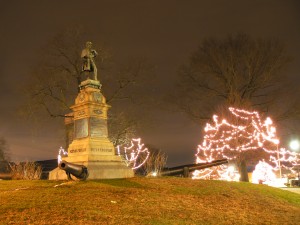 In honor of the holiday season, we’re running this nighttime image of the 1877 Soldier’s Monument on the west side of the Derby green.
In honor of the holiday season, we’re running this nighttime image of the 1877 Soldier’s Monument on the west side of the Derby green.
The monument, which we highlighted in a February post, honors Civil War veterans from Derby and present-day Shelton. The granite base was dedicated in 1877, and the bronze figure was added six years later.
Here’s our post from February, which includes more information as well as daytime images of the monument.
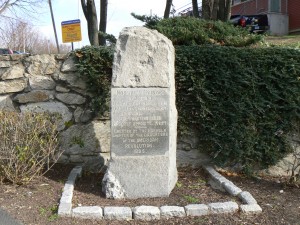 A stone marker near the East Norwalk train station marks the location of the earliest homesteads in Norwalk.
A stone marker near the East Norwalk train station marks the location of the earliest homesteads in Norwalk.
The granite monument bears an inscription on its west face reading “Norwalk founded A.D. 1649. Its earliest homes were planted in the near vicinity of this stone. First meeting house directly opposite west. Erected by the Norwalk chapter of the Daughters of the American Revolution 1895.”
The monument stands next to the driveway leading to the westbound Metro-North station, and is not far from the intersection of East Avenue and Fort Point Street (once part of a road connecting Stamford and Fairfield.
Norwalk was purchased from Native Americans in two transactions in 1640 and 1641 (the latter by Fairfield founder Roger Ludlow) and was settled nine years later. The city was incorporated in 1651, and its first meetinghouse was built across from the Founding Monument a year later.
